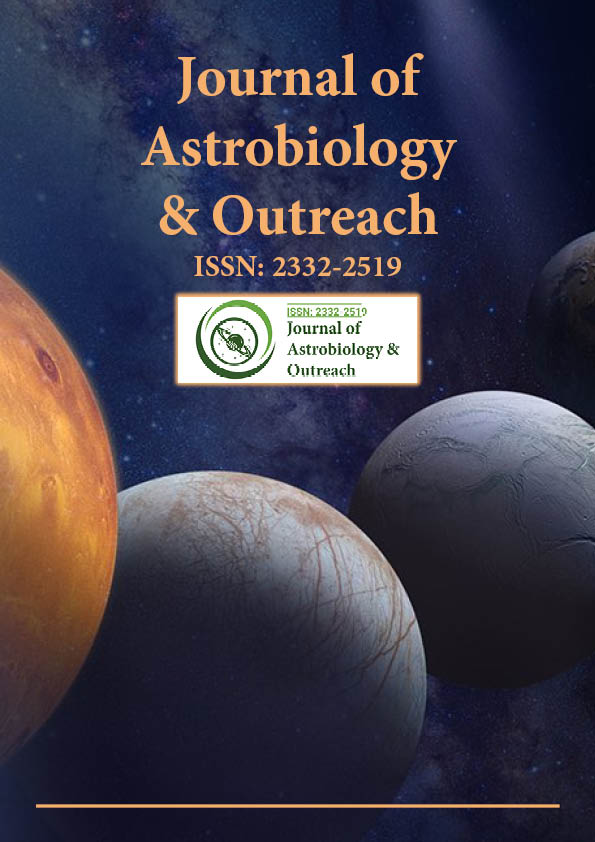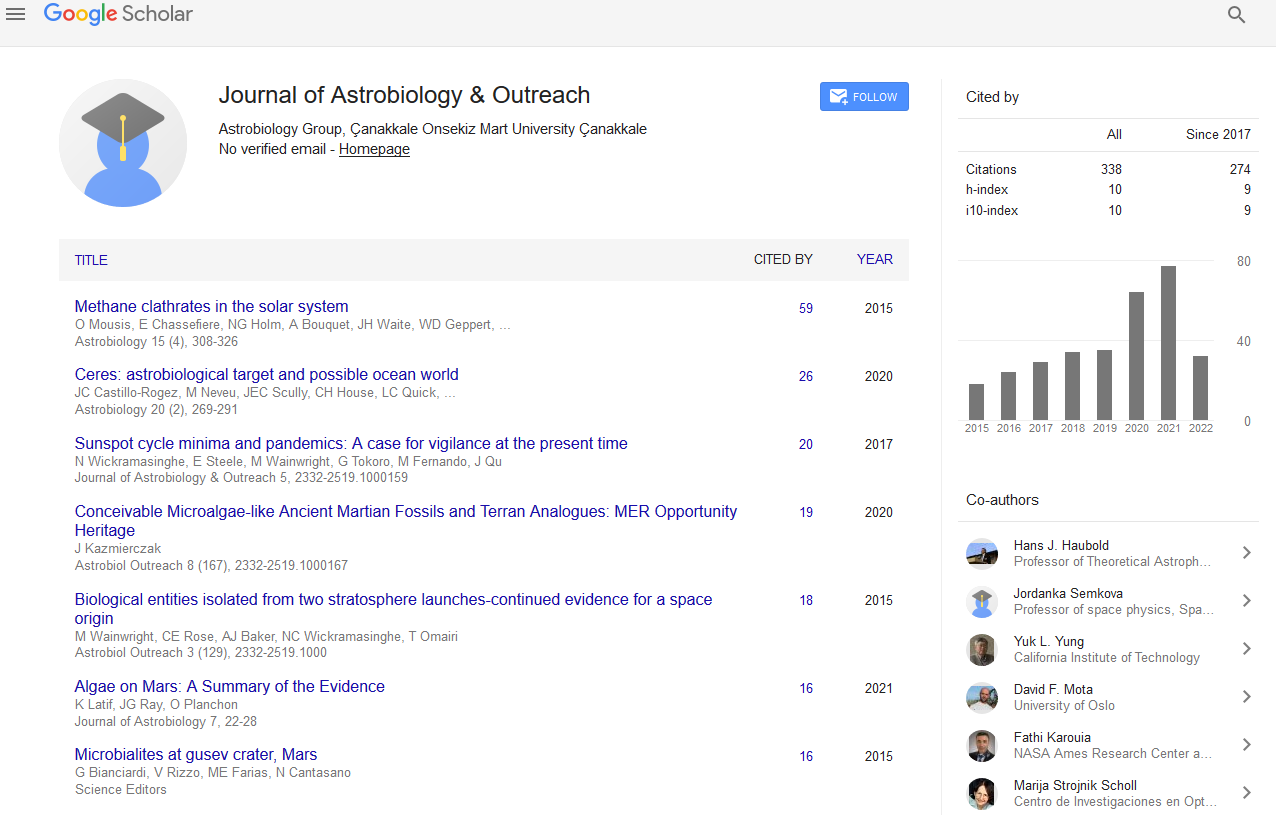Indexed In
- Open J Gate
- Academic Keys
- JournalTOCs
- RefSeek
- Hamdard University
- EBSCO A-Z
- OCLC- WorldCat
- Google Scholar
Useful Links
Share This Page
Journal Flyer

Open Access Journals
- Agri and Aquaculture
- Biochemistry
- Bioinformatics & Systems Biology
- Business & Management
- Chemistry
- Clinical Sciences
- Engineering
- Food & Nutrition
- General Science
- Genetics & Molecular Biology
- Immunology & Microbiology
- Medical Sciences
- Neuroscience & Psychology
- Nursing & Health Care
- Pharmaceutical Sciences
Perspective - (2023) Volume 11, Issue 3
Space Innovators: Mission Pathways to Inspire Students in Astronomy
Choohe Leo*Received: 01-May-2023, Manuscript No. JAO-23-21758; Editor assigned: 03-May-2023, Pre QC No. JAO-23-21758 (PQ); Reviewed: 17-May-2023, QC No. JAO-23-21758; Revised: 24-May-2023, Manuscript No. JAO-23-21758 (R); Published: 31-May-2023, DOI: 10.35248/2332-2519.23.11.301
Description
Space exploration is one of the most fascinating and inspiring fields of human endeavor. It challenges us to overcome the barriers of our knowledge, technology and imagination, and to discover new worlds and phenomena in the vastness of the cosmos. Space exploration also offers many benefits for humanity, such as advancing scientific understanding, fostering international cooperation, enhancing education and innovation, and inspiring future generations of scientists and engineers. However, space exploration is also a complex and costly endeavor that requires a high level of expertise, creativity and dedication. To ensure the sustainability and success of space exploration, it is essential to foster the development of a skilled and diverse workforce that can meet the current and future challenges and opportunities of this field. The main aim of space innovators is to combine education, science communication and research in astrobiology and robotics to engage and inspire students to pursue study and careers in space science and engineering. A series of workshops for students in grades, where they learned about various aspects of space exploration, such as astrobiology, robotics, planetary science, astronomy, engineering and mission design. The workshops were delivered by experts from academia, industry and government agencies, who shared their knowledge and experience with the students. The workshops also included hands-on activities, such as building and programming robots, conducting experiments with microorganisms, designing mission scenarios and using telescopes.
A national competition for students in grades, where they had to propose an innovative space mission concept that addressed a scientific question or a technological challenge related to space exploration. The competition was judged by a panel of experts from various fields and sectors. The winning teams received prizes and opportunities to visit space-related facilities and events in Australia and overseas. A research component that involved collecting data on the impact of the project on the students' attitudes, interests, knowledge and aspirations regarding space exploration and Science, Technology, Engineering, and Mathematics (STEM) disciplines. The research was conducted by a team of researchers from the University of New South Wales, who used surveys, interviews, focus groups and observations to evaluate the effectiveness of the project in achieving its educational objectives. The project achieved several positive outcomes for the students, the educators and the space community.
The project increased the students' awareness, understanding and appreciation of space exploration and its benefits for humanity. The students gained new insights into the scientific and technological aspects of space exploration, as well as its social, economic and environmental implications. The students also learned about the diverse career opportunities and pathways available in space science and engineering.
The project enhanced the students' interest, motivation and confidence in pursuing study and careers in space science and engineering. The project exposed the students to role models from various backgrounds and disciplines who shared their passion and enthusiasm for space exploration. The project also provided the students with opportunities to develop their skills in critical thinking, problem-solving, creativity, communication and collaboration.
The project improved the educators' capacity and resources to teach space science and engineering in an engaging and effective way. The project offered professional development opportunities for teachers who participated in the workshops or mentored the competition teams. The project also produced educational materials that can be used by teachers in their classrooms or by other educators in informal settings.
The project strengthened the collaboration and communication among various stakeholders in the space community. The project brought together experts from different fields and sectors who contributed their expertise, experience and perspectives to the project. The project also fostered connections between schools, universities, industry partners, government agencies and other organization’s involved or interested in space exploration.
Conclusion
This project had demonstrated the potential use in space exploration as a context for education, science communication and research. The project showed how space exploration can inspire students to pursue study and careers in STEM disciplines, especially space science and engineering. The project also showed how space exploration can foster innovation, collaboration and diversity in the space community and beyond.
The project has left a lasting legacy for the students, the educators and the space community who participated in or benefited from the project. The project has also paved the way for future initiatives that can build on the achievements and lessons learned from the project. Space exploration is a dynamic and evolving field that offers many opportunities and challenges for humanity. To realize the full potential of space exploration, it is vital to continue to support and nurture the next generation of space innovators and future scientists.
Citation: Leo C (2023 Space Innovators: Mission Pathways to Inspire Students in Astronomy. J Astrobiol Outreach. 11:301.
Copyright: © 2023 Leo C. This is an open-access article distributed under the terms of the Creative Commons Attribution License, which permits unrestricted use, distribution, and reproduction in any medium, provided the original author and source are credited.

